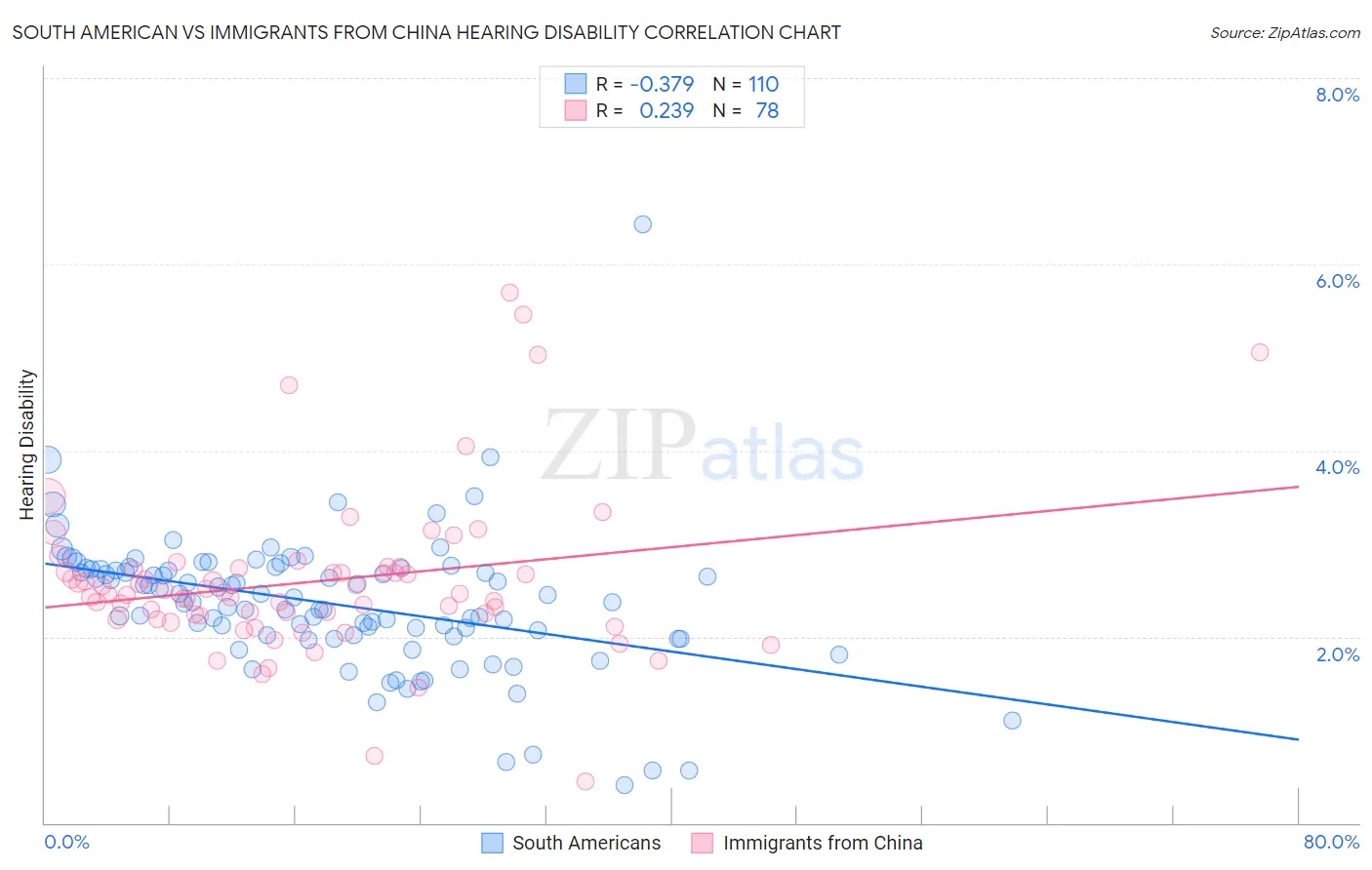South American vs Immigrants from China Hearing Disability
COMPARE
South American
Immigrants from China
Hearing Disability
Hearing Disability Comparison
South Americans
Immigrants from China
2.7%
HEARING DISABILITY
99.0/ 100
METRIC RATING
57th/ 347
METRIC RANK
2.6%
HEARING DISABILITY
99.5/ 100
METRIC RATING
39th/ 347
METRIC RANK
South American vs Immigrants from China Hearing Disability Correlation Chart
The statistical analysis conducted on geographies consisting of 493,776,851 people shows a mild negative correlation between the proportion of South Americans and percentage of population with hearing disability in the United States with a correlation coefficient (R) of -0.379 and weighted average of 2.7%. Similarly, the statistical analysis conducted on geographies consisting of 456,804,939 people shows a weak positive correlation between the proportion of Immigrants from China and percentage of population with hearing disability in the United States with a correlation coefficient (R) of 0.239 and weighted average of 2.6%, a difference of 2.0%.

Hearing Disability Correlation Summary
| Measurement | South American | Immigrants from China |
| Minimum | 0.40% | 0.45% |
| Maximum | 6.4% | 5.7% |
| Range | 6.0% | 5.2% |
| Mean | 2.4% | 2.6% |
| Median | 2.4% | 2.5% |
| Interquartile 25% (IQ1) | 2.0% | 2.2% |
| Interquartile 75% (IQ3) | 2.7% | 2.7% |
| Interquartile Range (IQR) | 0.71% | 0.49% |
| Standard Deviation (Sample) | 0.75% | 0.87% |
| Standard Deviation (Population) | 0.75% | 0.86% |
Demographics Similar to South Americans and Immigrants from China by Hearing Disability
In terms of hearing disability, the demographic groups most similar to South Americans are Immigrants from Nicaragua (2.7%, a difference of 0.040%), Immigrants from Ethiopia (2.7%, a difference of 0.070%), Ethiopian (2.7%, a difference of 0.13%), Immigrants from Eastern Asia (2.7%, a difference of 0.16%), and Jamaican (2.7%, a difference of 0.23%). Similarly, the demographic groups most similar to Immigrants from China are Haitian (2.6%, a difference of 0.080%), Immigrants from Jamaica (2.6%, a difference of 0.24%), Immigrants from Taiwan (2.6%, a difference of 0.42%), West Indian (2.6%, a difference of 0.43%), and Senegalese (2.6%, a difference of 0.43%).
| Demographics | Rating | Rank | Hearing Disability |
| Immigrants | Jamaica | 99.5 /100 | #38 | Exceptional 2.6% |
| Immigrants | China | 99.5 /100 | #39 | Exceptional 2.6% |
| Haitians | 99.5 /100 | #40 | Exceptional 2.6% |
| Immigrants | Taiwan | 99.4 /100 | #41 | Exceptional 2.6% |
| West Indians | 99.4 /100 | #42 | Exceptional 2.6% |
| Senegalese | 99.4 /100 | #43 | Exceptional 2.6% |
| Nigerians | 99.4 /100 | #44 | Exceptional 2.6% |
| Venezuelans | 99.4 /100 | #45 | Exceptional 2.6% |
| Immigrants | Dominica | 99.3 /100 | #46 | Exceptional 2.6% |
| Immigrants | Israel | 99.3 /100 | #47 | Exceptional 2.6% |
| Immigrants | Singapore | 99.3 /100 | #48 | Exceptional 2.6% |
| Immigrants | South America | 99.2 /100 | #49 | Exceptional 2.7% |
| Paraguayans | 99.2 /100 | #50 | Exceptional 2.7% |
| Immigrants | Hong Kong | 99.2 /100 | #51 | Exceptional 2.7% |
| Jamaicans | 99.0 /100 | #52 | Exceptional 2.7% |
| Immigrants | Eastern Asia | 99.0 /100 | #53 | Exceptional 2.7% |
| Ethiopians | 99.0 /100 | #54 | Exceptional 2.7% |
| Immigrants | Ethiopia | 99.0 /100 | #55 | Exceptional 2.7% |
| Immigrants | Nicaragua | 99.0 /100 | #56 | Exceptional 2.7% |
| South Americans | 99.0 /100 | #57 | Exceptional 2.7% |
| Immigrants | Peru | 98.6 /100 | #58 | Exceptional 2.7% |